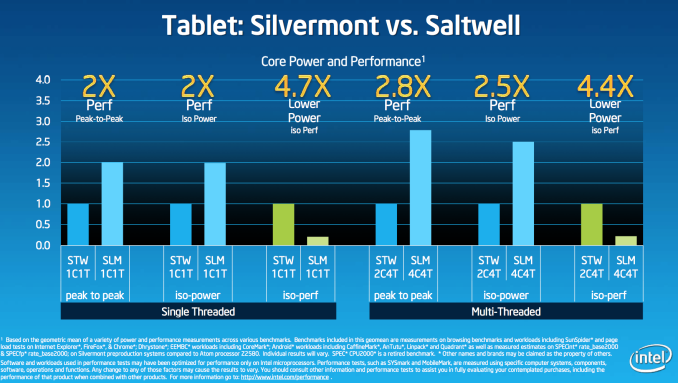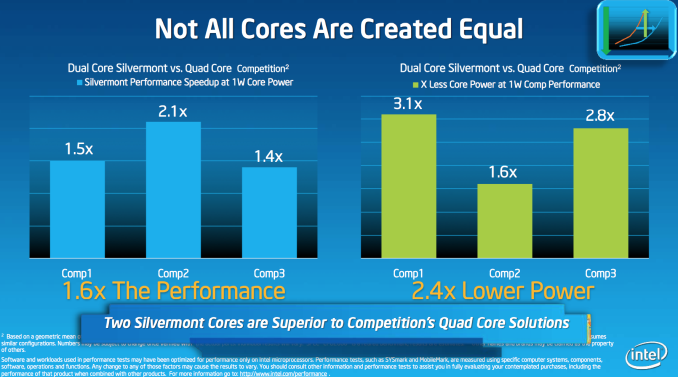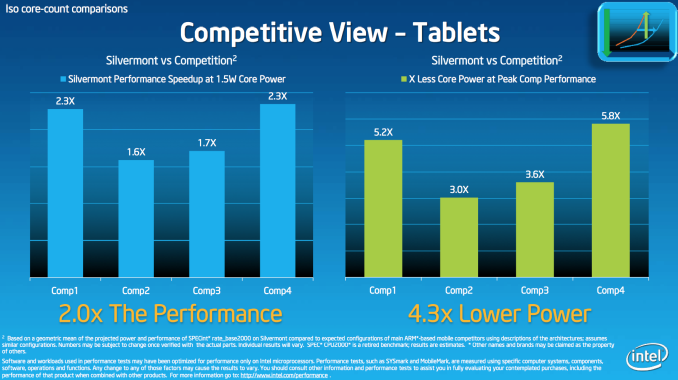Intel’s Silvermont Architecture Revealed: Getting Serious About Mobile
by Anand Lal Shimpi on May 6, 2013 1:00 PM EST- Posted in
- CPUs
- Intel
- Silvermont
- SoCs
Tablet Expectations
Intel is getting architectural details about Silvermont launch ahead of actual SoCs based on the CPU. Baytrail tablets based on Silvermont cores are currently in development and are expected to show up by the end of the year. The Silvermont story at the end of this year should be a lot better than Clovertrail last year. Windows 8 will be in its second major revision (codename Windows Blue) and Intel will launch with both Android and Windows tablet availability. The inclusion of Android is very important to hitting lower price points, something Clovertrail really didn’t have last year. We should see Baytrail based tablets span the gamut of Nexus 7 to iPad pricing, with Haswell picking up where Silvermont ends.
Form factors should be no thicker than Clovertrail based designs, although it will be possible to go thinner with Baytrail/Silvermont should an OEM decide to. Displays should also be a lot better this time around. Intel is working with some OEMs on color calibration, an important step forward as I’m hearing Qualcomm will be doing the same with Snapdragon 800. We’ll also finally see resolutions higher than 1366x768, including potentially some competition for the iPad with Retina Display. Silvermont’s new system agent should do a good job of prioritizing GPU access to main memory in these ultra high resolution scenarios.
Performance
With tablets still months away from being production ready, there’s nothing for us to publicly test. Intel did share some of its own numbers off of its Baytrail reference tablet however, and they are impressive.
All of the Intel comparisons report the geometric mean performance advantage over a spectrum of benchmarks. The benchmarks used include SPECint2K, CoreMark, SunSpider, web page load tests in IE/Chrome/Firefox, Linpack, AnTuTu and Quadrant (ugh) among others. The point here isn’t to demonstrate absolute peak performance in one benchmark, but to instead give us a general idea of the sorts of gains we should expect to see from Silvermont/Baytrail tablets vs the competition. It’s an admirable effort and honestly the right way to do things (short of actually giving us a pre-production tablet to test that is). We’ll start with a comparison to Saltwell, the previous-generation 32nm Atom core. The Saltwell results are listed as STW while Silvermont is abbreviated SLM:
In terms of absolute performance, Silvermont’s peak single threaded performance is 2x that of Saltwell. This 2x gain includes IPC and clock frequency gains (only 50% is from IPC, the rest is due to IDI, system agent and frequency). Given that Saltwell is competitive with existing architectures from ARM and Qualcomm (except for the Cortex A15), a 2x increase in single threaded performance should put Silvermont in a leadership position when it arrives later this year.
The next set of bars is just as important. At the same power levels (Intel didn’t disclose specifically at what power), Silvermont delivers 2x the performance of Saltwell. Finally, at the same performance level, Silvermont uses 4.7x lower power. Given that Saltwell wasn’t terrible on power to begin with, this is very impressive. Without knowing the specific power and performance levels however, I wouldn’t draw too many conclusions based on this data though.
The multithreaded advantages are obviously even greater as Silvermont will be featured in quad-core configurations while Saltwell topped out at dual-core (4 threads) in tablets.
In the next two slides, Intel did some competitive analysis with Silvermont vs. the ARM based competition. The benchmarks are the same, but now we have specifics about power usage. In the first test Intel is comparing to three competitors all with quad-core designs. Intel claims to have estimated performance gains based on what is expected to be in the market by the end of this year. Intel’s performance modeling group is very good at what it does, but as with any estimate you always have to exercise some caution in buying the data until we have physical hardware in hand.
Intel isn’t naming the three competitors in this chart, but there are only a finite number of quad-core ARM players shipping in decent tablet designs these days. The chart on the left compares performance of a dual-core Silvermont to quad-core ARM based designs at a 1W core power level. This comparison is extremely important because it’s effectively demonstrating the type of advantage Intel hopes to have in smartphones next year.
The chart on the right fixes performance and shows the reduction in core power. Do keep in mind that there can be a big difference between core and device level power, although Intel does expect to be very competitive on battery life this round.
The final performance comparison slide increases max core power to 1.5W and compares quad-core Silvermont to the quad-core competition. You’ll note the arrival of a new competitor here. One of the bars is a dual-core SoC with its performance scaled to four cores. I’m less confident about that particular estimation simply because it assumes Apple won’t significantly update architectures in its next generation of iPads.
The performance deltas here are huge. If we assume that at least one of these bars represents a Cortex A15 based design, Silvermont looks very good.
That’s the end of the Intel data, but I have some thoughts to add. First of all, based on what I’ve seen and heard from third parties working on Baytrail designs - the performance claims of being 2x the speed of Clovertrail are valid. Compared to the two Cortex A15 designs I’ve tested (Exynos 5250, dual-core A15 @ 1.7GHz and Exynos 5410 quad-core A15 @ 1.6GHz), quad-core Silvermont also comes out way ahead. Intel’s claims of a 60% performance advantage, at minimum, compared to the quad-core competition seems spot on based on the numbers I’ve seen. Power is the only area that I can’t validate based on what I’ve seen already (no one has given me a Baytrail tablet to measure power on). Given what we know about Silvermont’s architecture and the gains offered by Intel’s 22nm process, I do expect this core to do better on power than what we’ve seen thus far from ARM’s Cortex A15.
There is something we aren’t taking into account though. As of now, the only Cortex A15 based SoCs that we’ve seen have been very leaky designs optimized for high frequency. Should an SoC vendor choose to optimize for power consumption instead, we could see a narrower gap between the power consumption of Cortex A15 and Silvermont. Obviously you give up performance when you do that, so it may not ultimately change anything - but the power story might be less of a blowout.













174 Comments
View All Comments
Hector2 - Friday, May 17, 2013 - link
There are only 3 companies right now left in the world who have the muscle and volume to afford high tech fabs -- Intel, Samsung & TSMC. And Intel has about a 2 year lead. That means not just higher performance and lower power than before, but lower cost. Making the chips smaller multiplies the number of chips on a single, fixed-cost wafer and lowers costs. If the chip area is 1/2, the costs to make it are about 1/2 as well. 22nm tech gives Intel faster chips with less power than their competition. 14nm hits it out of the park.BMNify - Wednesday, June 5, 2013 - link
You're absolutely wrong about "lower cost". x86 requires more die area. The process is more volatile (more failed wafers).If we combine the 2 above factors with better performance, lower power consumption and toss in a lack of experience we get GT3e. A technological marvel that few (OEMs) want.
BMNify - Wednesday, June 5, 2013 - link
Spot on Krysto - It's Intel's process advantage that is shining through. Soon they'll hit the point of diminishing returns and/or the rest of the market will catch up/get close enough. When I see AMD at 32nm (Richland) having lower power draw at idle than Intel at 22nm (Ivy Bridge) I wonder how special their "secret sauce" actually is.How long can Intel loss-lead? Probably as long as Xeon continues to make up for it but ARM is getting into the server market now too (looking forward to AMD and Calexda ARM SoCs for the server market). Should be interesting in 3-5 years
TheinsanegamerN - Monday, August 26, 2013 - link
only issue, though, is when you put that richland chip under load. all of a sudden, intel is using much less power.t.s. - Monday, May 6, 2013 - link
"The mobile market is far more competitive than the PC industry was back when Conroe hit. There isn’t just one AMD, but many competitors in the SoC space that are already very lean fast moving. There’s also the fact that Intel doesn’t have tremendous marketshare in ultra mobile."Well, with their 'strategy' back then when facing AMD (http://news.bbc.co.uk/2/hi/8047546.stm), they surely'll win. :p
nunomoreira10 - Monday, May 6, 2013 - link
It´s kinda suspicious that there are many comparisons against arm but none against Amd jaguar or even bobcat.jaguar will probably be a much better tablet cpu and gpu, while intel competes on the phone market.
Khato - Monday, May 6, 2013 - link
Which AMD Jaguar/Bobcat SKU runs at 1.5 watts? They aren't included in the comparison because they're a markedly higher power level.nunomoreira10 - Monday, May 6, 2013 - link
they will both be used on fan-less tablet designs...extide - Tuesday, May 7, 2013 - link
Totally different markets. Jaguar/Bobcat will likely line up next to low end Core/Haswell, not an Atom/SilvermontPenti - Tuesday, May 7, 2013 - link
Both will sadly be way to underpowered when it comes to the GPU, and that matters greatly on general OS's and applications like running a desktop OS X or Windows (or GNU/Linux) machine. You won't really be able to game on them at all as it's not smartphone games people want to run. GPGPU won't really be fast enough for anything and we talk about ~100-200 GFLOPs GPU-power on the AMD side for what is essentially a full blown computer.Intel is clearly targeting the phone market. Something AMD/ATI divested from years back with their mobile GPU tech going to Qualcomm (Adreno, which isn't Radeon-based) and Broadcom. ATIs/AMDs mobile GPU-tech was before that previously licensed to or used together with the likes of Intel (PXA/XScale – not integrated though), Samsung and Freescale among others. Their technology already is the mainstay of the mobile business and was departed from the company but in effect their technology know how was successful in the market without their leadership so why would they compete with that, of course they wouldn't.
AMD simply has not and will not likely any time soon invest in an alternate route to dominate their own part of the smartphone/ARM-tablet market while Intel has with integrated designs replacing the custom ARMv5TE design. AMD going after ARM-business is different since they will license the core and their manufacturer GloFo already does manufactures and even offers hard macros for ARM-designs that they sell a bunch of to other customers already. It's also going after other embedded fields and the emerging ARM-server/appliance space all without designing custom cores.
While PXA (Intel) was quite successful in the market, moving to x86 and doing away with stuff like ARM-based network processors, raid-processors allows Intel to focus on delivering great support for modern ISA across all sorts of devices, while it didn't make it into phones (until lately) like PXA which continued to power Blackberrys under Marvell, was the main Windows Mobile platform for years after Intels departure and so on it was able to become a multimediaplatform, and a widely adopted chip for embedded use, driving NAS-devices and the like. Thanks to the Intel purchase of Infineons Wireless portfolio including many popular 3G radios/modems and them forming a new wireless division their actual business and sales in the mobile market is also much higher than when they still had their custom PXA/XScale lineup. Plus they couldn't have competed with their XScale lineup without designing new ARM-ISA compatible cores/designs to be able to match Cortex A8, A9, A7, A15, Krait 600 etc. Plus puts them in a much better place to be a wireless/terminal supplier when they can support customers who want advanced wireless modems/baseband, Application processors, bt, wifi etc. While Nvidia will have Tegra 4i with integrated modem AMD couldn't offer anything similar as they have no team capable of producing radio baseband. Having modern compilers and x86-ISA sure makes it convenient now for Intel, as well as integrating their own GPU, just licensing ARM Ltd designs wouldn't have put them in a better position to continue their presence in the mobile field. They have basically developed and scaled their desktop GNU/Linux drivers in the Linux Kernel, added mobile features and so on years before they put the hardware and can leverage that software in mobile platforms (Android) but it makes sense and they don't have to rely on IP cores and third party drivers for graphics with the coming Bay Trail. They couldn't have shared that much tech if they were anything else then x86. Of course AMD won't be in the same place and scaling down a GPU designed for thousands of stream processors and Windows/OS X drivers to put it into phones is not the same. It would be awful if it is just scaled down to fit the power usage, even if Nvidia has kinda custom mobile gpu it's still worse then the competitors which has no presence in desktop computing. Drivers for QNX, Android/Linux, iOS etc is not the same as with Windows either. It takes a long time to start over when they did away with an okay solution (z460), and they haven't but other have and thats fine, there is more competition here then elsewhere. x86 is no stopper for Intel.